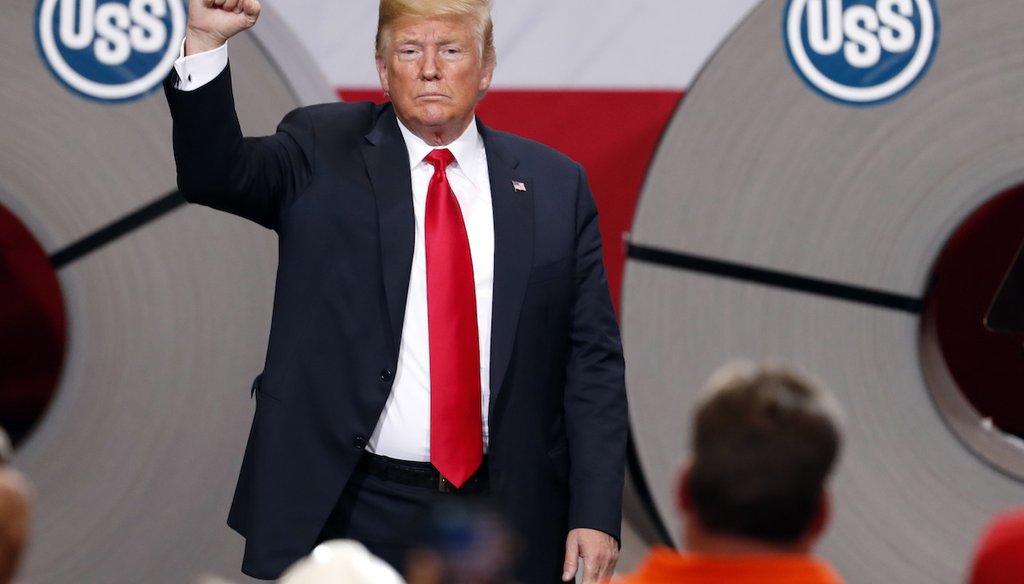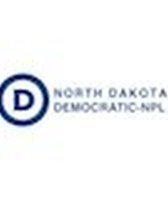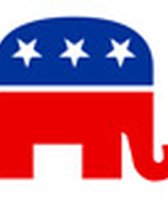Stand up for the facts!
Our only agenda is to publish the truth so you can be an informed participant in democracy.
We need your help.
I would like to contribute

President Donald Trump speaks at the United States Steel Granite City Works plant in Illinois on July 26, 2018.
For workers in America’s heartland, the good news of savings from President Donald Trump’s tax cuts is getting overshadowed by concern over his disruptive trade policies.
Sen. Heidi Heitkamp, one of a few Democrats facing tight midterm battles this fall, said the harm from Trump’s tariffs outweighed the benefits of tax cuts for North Dakotans she represents.
"My equipment manufacturers tell me whatever advantage they've gotten from the tax code change has been eaten up in the very early months of the steel and aluminum tariffs," Heitkamp said on CNBC on July 20, 2018.
We wanted to fact-check these types of comments, but we have found it hard to measure the impact of tariffs. The best we can do is look at economic models mapping out the impacts of the tariffs, which echo Heitkamp’s claim.
The U.S. International Trade Commission has the full tariff schedule, which includes thousands of affected products including solar panels, washing machines, steel and aluminum. The Tax Foundation found tariffs will apply to roughly $96 million worth of imports.
No government entity analyzes the financial toll of tariffs on industries, but tax and trade organizations are analyzing just that. The Tax Foundation estimated that if 2018 imports equal 2017 levels, the aluminum and steel tariffs alone could cost U.S. firms nearly $9 billion.
Anecdotal responses include Harley Davidson’s decision to move production overseas following the 33 percent tariff Europe slapped on U.S. motorcycles, a response to Trump’s tariffs on imported steel and aluminum. And U.S. soybean prices dropped by over 20 percent after China placed a 25 percent tariff on them in response to Trump’s tariffs on $200 billion in Chinese goods.
Some of the most dire consequences will not be apparent for months or even years. We can expect clearer signs of the impact by the end of the year, although generous tax cuts and other factors may compensate some metrics, making attribution difficult.
The scope of the damage depends on whether the tariffs cease or escalate.
Economists tell us the effects of the tariffs, while imprecise so far, are not pretty. Here’s a basic rundown.
Tariffs are taxes on certain imports from another country paid by a country’s own population. They raise prices for manufacturers, which are passed onto customers, or for customers directly.
When manufacturing costs up, manufacturers have to either adjust to the higher cost or find something to replace the imported good. Sometimes the replacement might create jobs domestically, but imports are not always easily switchable, like steel.
With higher prices, demand goes down, and so on the retail end, jobs suffer. However, experts said jobs are the last in a series of cost-reductions that firms will take in reaction to tariffs.
Other countries retaliate to U.S. tariffs by putting tariffs on U.S. goods sold in their own countries, like China’s tariff on U.S. soybeans. China still has to get soybeans from somewhere, and so far their eyes are set on Brazil. As a consequence, U.S. producers lose valuable customers they may not regain, and must drive prices down to compete with the foreign goods.
The effect is lower prices and lower export levels, but some of these effects are only now starting to show. In anticipation of the tariffs, the agricultural industry pushed out more exports than usual, which postponed the price effects for months.
"People are saying, ‘Why aren’t exports down?’ " said Laura Baughman, president of the Trade Partnership Worldwide, LLC. "It’s because they were doing all this advanced preparation to get around all the harm that would be coming later. So it’s going to be in the last half of the year that tariffs start showing up in producer and eventually consumer prices."
Those price drops have ripple effects, too. Andrea Durkin, editor of the Center for Strategic and International Studies’ TradeVistas website, said farmers worried this season’s losses would impact their ability to secure future loans. David Laborde, senior researcher at International Food Policy Research Institute, said price drops would also drive down the price of farmers’ lands.
Besides producer and consumer prices, the effects can be seen in the fiscal policy of the central bank. While the Fed’s interest rate hike in June cannot be attributed only to tariffs, they play a role, as tariffs accelerate inflation, which higher interest rates aim to fix. Those, in turn, trigger higher borrowing rates for consumers.
Stock prices and investment are two other key indicators of the impacts of tariffs. The stock market following second quarter earning reports are a good place to look, Baughman said.
"Companies are reporting they are taking hits, and that is affecting stock prices," Baughman said. "Even though it hasn’t shown a bad impact, it could going forward, depending on how much reports impact stock prices."
Stocks in Alcoa, a big aluminum producer in Pennsylvania, are only starting to take small dips, and that’s months after Trump’s aluminum tariffs went into effect.
Slowed investment activity is another sign of harm. Inaction on investment translates to a hit to the economy, as capital isn’t generating profit and companies aren’t innovating because they’re unsure if there will be a market for their products.
However, a fall in investment this year due to trade uncertainty may be offset by increased investment because of the generous tax cuts.
So even if investment takes a hit from tariffs, it may not be immediately noticeable because of the boost the tax cut provided.
On July 24, Trump announced a $12 billion aid package to farmers caught in the tariff tug of war.
While record-breaking, experts told us the package was unlikely to cover the full extent of farmers’ costs.
Our Sources
Twitter, Kyle Pomerleau, July 20, 2018
Tax Foundation, Tracking The Economic Impact of U.S. Tariffs and Retaliatory Actions, June 22, 2018
Bloomberg, Automakers Saved on Tax Cuts. Here’s How Much Could Be Wiped Out by Tariffs, July 24, 2018
New York Times, If the Trade War Starts to Damage the Economy, Here’s How You’ll Be Able to Tell, July 11, 2018
PolitiFact, Donald Trump falsely blames trade deals for lower soybean prices, July 24, 2018
USITC.gov, Harmonized Tariff Schedule (2018 HTSA Revision 7), accessed July 27, 2018
CNBC, Democratic Sen. Heitkamp: Benefits of tax cuts to US workers have been 'eaten up' by Trump's tariffs, July 20, 2018
FederalReserve.gov, Federal Reserve issues FOMC statement, June 13, 2018
Phone interview with Laura Baughman, president of the Trade Partnership Worldwide, LLC, July 26, 2018
Phone interview with David Laborde, senior researcher at International Food Policy Research Institute, July 26, 2018
Phone interview with Julia Krieger, Heitkamp campaign spokeswoman, July 27, 2018
Email interview with Edward Alden, senior fellow at the Council on Foreign Relations, July 25, 2018
Email interview with Andrea Durkin, editor of the Center for Strategic and International Studies’ TradeVistas website, July 25, 2018








































